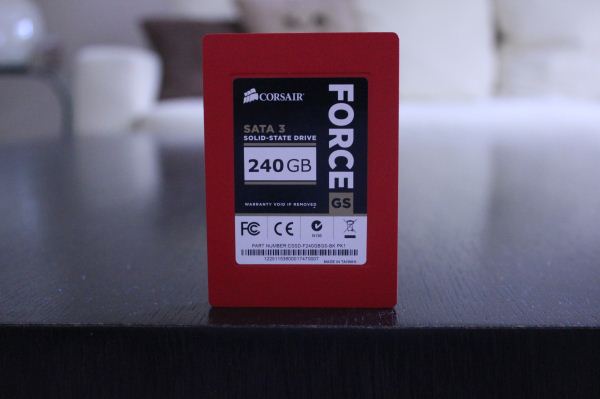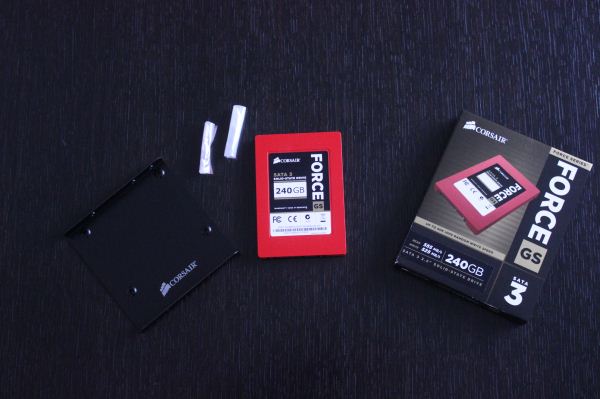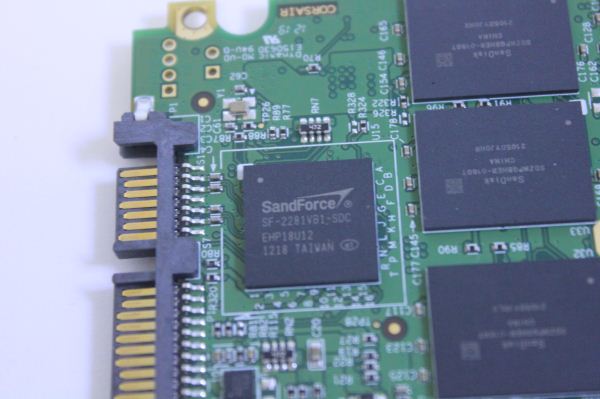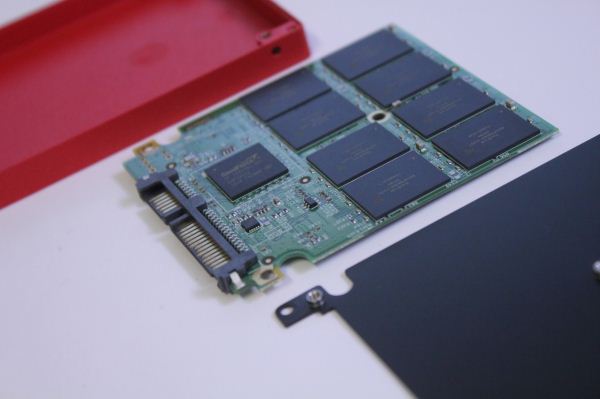SandForce TRIM Issue & Corsair Force Series GS (240GB) Review
by Kristian Vättö on November 22, 2012 1:00 PM ESTInside The Corsair Force GS
Corsair's Force GS uses a similar red plastic chassis as the Force GT.
Included in the retail bundle are two sets of mounting screws and a 2.5" to 3.5" adapter.
The actual PCB is a bit different from what we normally find inside 2.5" SSDs. Its length is only about four fifths of the backplane and it's held in tact by three screws (two in the corners, one in the middle) instead of four. I'm guessing the smaller PCB is slightly cheaper than a regular size 2.5" PCB would have been, hence Corsair opted for one. I don't really see any other explanation because the chassis is still normal size and weight benefit is marginal.
As for the components, there are eight SanDisk's 24nm Toggle-Mode MLC NAND packages on this side of the PCB. These are 16GB packages, meaning that each package consists of two 8GB dies.
Remove the backplane and flip the PCB around and we find another eight NAND packages and SandForce's SF-2281 controller.
Corsair isn't using thermal pads, which isn't all that suprising. Typically thermal pads are only found in high-end SSDs while lower-end models come without in order to offer more competitive pricing.
Test System
| CPU |
Intel Core i5-2500K running at 3.3GHz (Turbo and EIST enabled) |
| Motherboard |
AsRock Z68 Pro3 |
| Chipset |
Intel Z68 |
| Chipset Drivers |
Intel 9.1.1.1015 + Intel RST 10.2 |
| Memory | G.Skill RipjawsX DDR3-1600 2 x 4GB (9-9-9-24) |
| Video Card |
XFX AMD Radeon HD 6850 XXX (800MHz core clock; 4.2GHz GDDR5 effective) |
| Video Drivers | AMD Catalyst 10.1 |
| Desktop Resolution | 1920 x 1080 |
| OS | Windows 7 x64 |
















56 Comments
View All Comments
R3dox - Friday, November 23, 2012 - link
I see, but that doesn't really answer my question :P.Is there still a performance hit and do you just choose to test under normal rather than optimal conditions or is this a thing of the past?
Kristian Vättö - Friday, November 23, 2012 - link
I tested this quickly a while back but there was no significant difference in performance (small variation always occurs anyway):http://forums.anandtech.com/showthread.php?t=22721...
R3dox - Friday, November 23, 2012 - link
Thanks for the replies :).You say "AFAIK it affected performance with some older SandForce SSDs but when I started testing SSD and asked Anand for all the settings, he just told me to leave it on since it doesn't matter anymore".
But it's a clear difference on my old postville. Granted, the SSD is my boot disc during those tests, but isn't that their most likely use anyway? TBH I'd be interested to know why enabling those powersaving features apparently impact performance only when used as boot disc. When I say 'impact", I mean based on multiple runs, of course.
Lastly, it seems that C-states are the most impactful setting and that one isn't mentioned in the reviews. I suppose you've left those on as well?
JellyRoll - Wednesday, December 5, 2012 - link
that wasnt testing.Schugy - Tuesday, November 27, 2012 - link
Don/t buy MLC rubbish. SLC is really worth it.FunnyTrace - Wednesday, November 28, 2012 - link
Nice going SandForce.1) BSOD problem
2) AES-256 hardware doesn't work (seriously??? hardware doesn't work???)
3) TRIM has not been working properly (what, you failed to GC blocks properly?)
As a lot of people mention, these SSD makers want to use early adopters and PC building enthusiasts as guinea pigs.